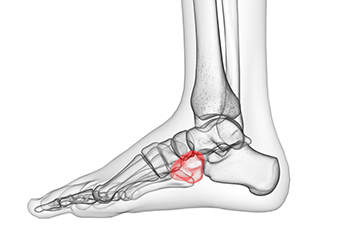
Cuboid syndrome, a lesser-known foot ailment, can gradually disrupt one's daily activities. This condition occurs when the cuboid bone, which is situated on the outer side of the foot, shifts out of its normal position. This misalignment can affect nearby joints and ligaments. While often mistaken for a sprain, cuboid syndrome can cause pain and discomfort, particularly during weight-bearing movements. Cuboid syndrome is typically triggered by activities involving sudden twists or impacts, such as sports or falls. People with flat feet or those engaging in repetitive motions are also susceptible. Poor footwear choices, inadequate arch support, and excessive pronation can contribute to developing cuboid syndrome. Recognizing the causes is the first step in managing this condition. If you have pain on the outside of your foot, it is suggested that you visit a chiropodist who can effectively diagnose and treat cuboid syndrome.
Cuboid syndrome, also known as cuboid subluxation, occurs when the joint and ligaments surrounding the cuboid bone in the foot become injured. If you think that you may have cuboid syndrome, please consult with Emily Yu, B.Sc from Uptown Foot Care Clinic. Our specialist will assess your condition and provide you with quality foot and ankle treatment.
Causes
The cuboid bone is one of the seven tarsal bones located in the foot. Cuboid syndrome develops when the cuboid bone moves down and out of alignment with the other bone (calcaneus bone) in the joint of the foot. Cuboid syndrome can be the result of a sudden injury like an ankle sprain, or it may develop slowly over time from repetitive tension through the bone and surrounding structures.
Symptoms
The most common symptom of cuboid syndrome is pain on the outside of the foot which may worsen with activity.
Other possible symptoms include:
Difficulty bearing weight on the affected foot
Swelling
Sensitivity on the bottom of the foot
Reduced range of motion
Diagnosis
A chiropodist can diagnose cuboid syndrome based on your medical history and a physical examination of the foot. Imaging studies, such as X-rays or MRIs, often fail to show the dislocated cuboid.
Treatment
Treatment often includes resting, icing, compressing and elevating the affected foot, taping, wearing orthotic inserts, and taking anti-inflammatory medications to reduce pain. The chiropodist may also be able to manipulate the dislocated bone back into alignment.
If you have any questions, please feel free to contact our office located in . We offer the newest diagnostic and treatment technologies for all your foot care needs.
